Huawei P10 and P10 Plus: Performance & Battery Life Report
by Matt Humrick on May 12, 2017 7:00 AM ESTCPU & System Performance
The P10 and P10 Plus both use the same Kirin 960 SoC from HiSilicon as Huawei’s other flagship phone, the Mate 9. We already looked at Kirin 960’s performance and power efficiency in detail, and we also reviewed the Mate 9 earlier this year, so the two P10’s we’re testing now should not provide many surprises. The only outstanding questions are what type of RAM and NAND our units have, and do the P10s still perform the same as the larger Mate 9?
To evaluate overall system performance, we turn to the PCMark Work 2.0 suite, which tests the combined effects of the CPU, GPU, RAM, and NAND storage. Because it uses standard Android API calls and runs several different real-world workloads that elicit realistic behavior from the CPU governor (unlike synthetic tests that simply run one or more CPUs at max frequency), it’s a good indicator of everyday performance.
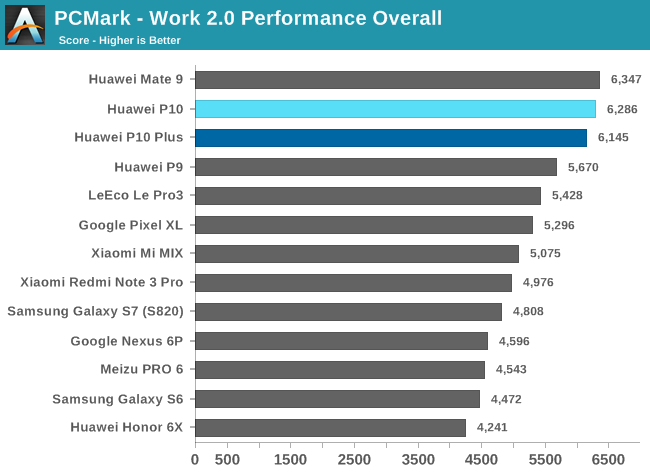
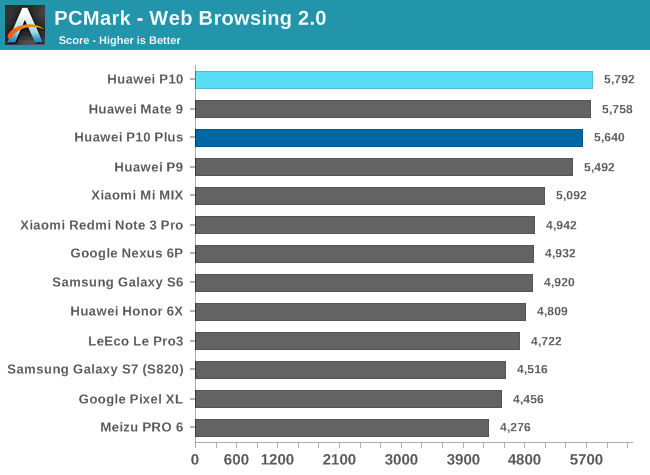
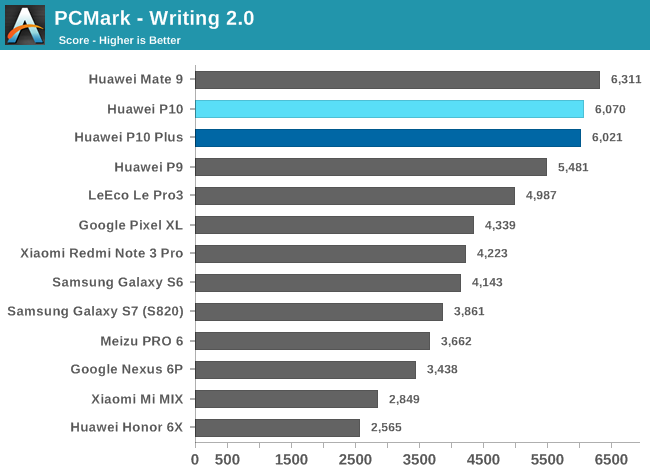
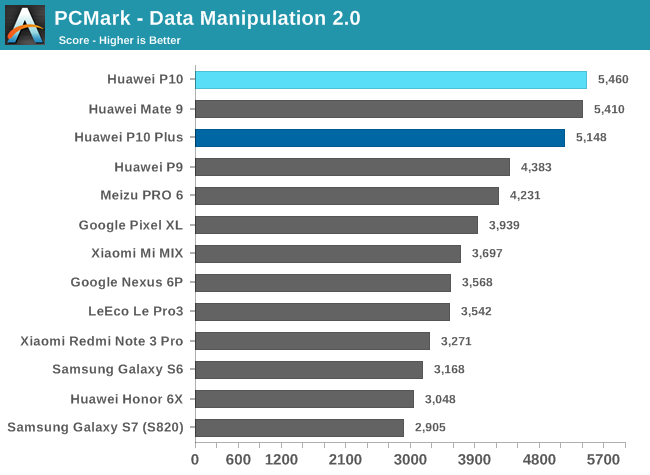
As expected, there’s no significant performance difference between the P10, P10 Plus, and Mate 9 in any of the PCMark Work 2.0 tests. All three phones post excellent results, with the P10 outperforming the older P9 and its Kirin 955 SoC by 11% overall.
There is not much difference between Huawei’s current generation flagships and last year’s P9 and Mate 8 in the Web Browsing test. The P10 Plus holds a slim 11% lead over Xiaomi’s Mi MIX and its Snapdragon 821 SoC, which grows to a more significant 27% lead over the Galaxy S7 and Pixel XL.
The Writing test is characterized by frequent but short bursts of activity that benefit from running on the big CPU cluster. While CPU IPC and frequency are important here, so is the phone’s proclivity to migrate threads onto the big cores. Huawei’s phones perform well once again in this test, with the P10 maintaining its roughly 11% advantage over the P9. There’s significantly more variation among the other phones in the chart, with the Mi MIX landing near the bottom at only half the performance of the P10. The Pixel XL trades places with the MIX in this test, but is still outperformed by the P10 by about 40%.
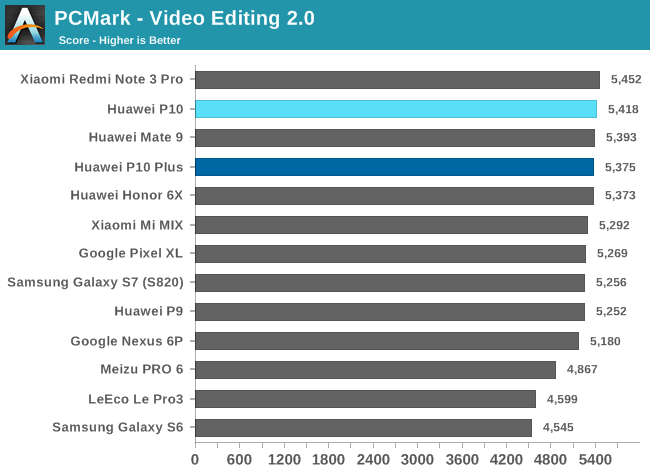
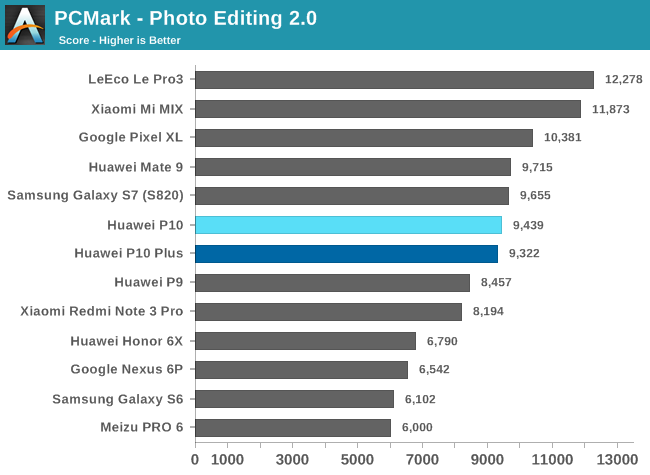
The PCMark Video Editing test is not particularly strenuous, so most phones perform about the same. The Photo Editing test, which uses both the CPU and GPU for applying various photo effects, produces more interesting results. It’s the only PCMark test where Huawei’s phones do not finish on top. Instead, phones using Snapdragon 820/821 SoCs and Qualcomm’s Adreno 530 GPU perform the best when running these workloads. The P10 holds a slim 12% advantage over the P9, but the Snapdragon 821 powered Le Pro3 is 30% faster.
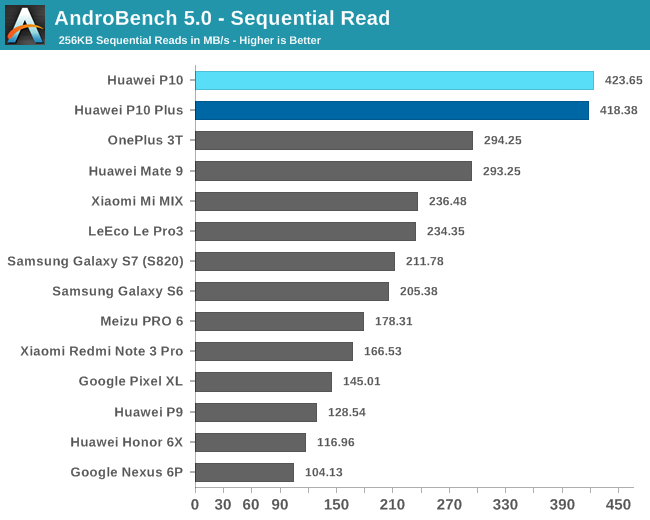
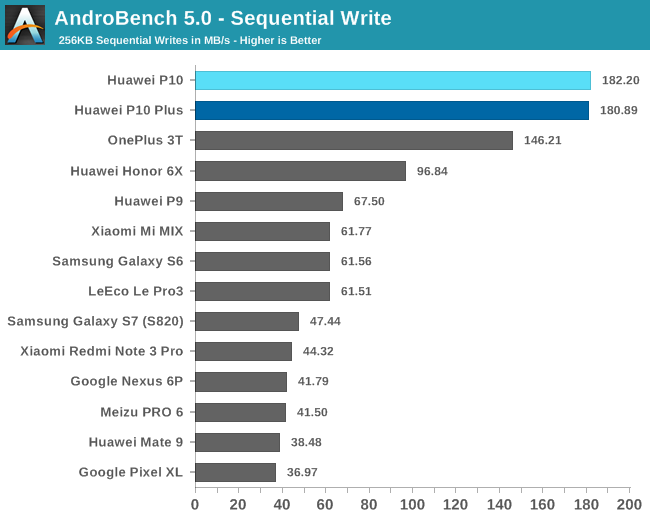
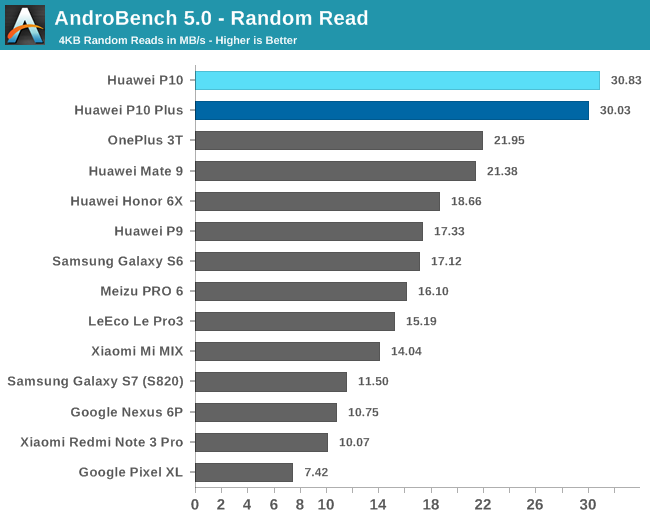
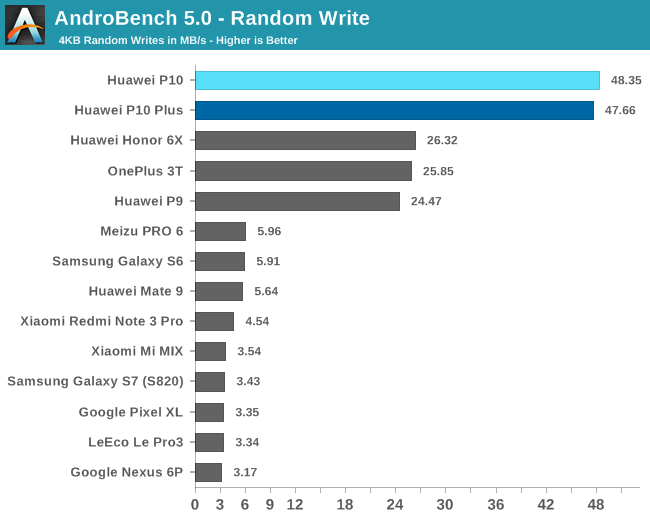
Obviously there is nothing wrong with storage performance for our P10s. Both the P10 and P10 Plus post excellent (and essentially identical) sequential and random throughput values. It’s also worth noting that both units are using UFS 2.0 NAND from Samsung.
The P10s easily outperform the Mate 9, especially when writing data sequentially or randomly. This particular Mate 9 is using UFS 2.0 NAND from Toshiba, which illustrates an important point: Just because a phone uses UFS 2.0 or 2.1 NAND does not mean it will perform well. Storage performance is multi-layered, starting with the operating system kernel and eventually ending at the storage controller and NAND itself. Even the underlying filesystem makes a big difference, with the P10, P10 Plus, P9, Mate 9, and OnePlus 3T all using the better performing F2FS (Flash-Friendly File System) for the /data partition instead of the default EXT4 file system.
With all of these variables in play, it’s impossible to even say that UFS NAND is always faster than eMMC NAND. For example, the Huawei P9, which uses eMMC 5.1 NAND, outperforms the newer Pixel XL and its UFS NAND in all but the sequential read test. The P9 also outperforms the Mate 9 in both writing tests. Now this does not mean a P10 with eMMC 5.1 NAND would perform the same or better than the two UFS examples we tested (it would not be able to match the sequential numbers at least), but it is important to take a step back and see the bigger picture.
| Storage Performance (AndroBench 5.0) | ||||||||
| Seq. Read (KB) |
Seq. Write (KB) |
Random Read (KB) |
Random Write (KB) |
|||||
| 1024 | 2048 | 1024 | 2048 | 8 | 16 | 8 | 16 | |
| Huawei P10 | 499.35 | 541.97 | 185.50 | 185.18 | 55.73 | 96.00 | 84.86 | 139.32 |
| Huawei P10 Plus | 516.78 | 558.45 | 182.24 | 183.15 | 53.22 | 93.37 | 82.52 | 137.51 |
| Huawei Mate 9 | 429.17 | 480.07 | 74.60 | 100.01 | 38.81 | 66.27 | 10.77 | 16.99 |
| Huawei Honor 8 | 169.07 | 198.77 | 83.65 | 102.45 | 30.2 | 46.25 | 17.17 | 26.59 |
The table above shows how storage performance scales with larger IO sizes. While the values we use in our general tests above represent the most common IO sizes, other workloads, notably accessing media files like photos and video, will utilize larger IO transfers, so it’s important to see how a phone performs over a wider range of scenarios. Sequential read throughput for the P10s continues to scale as expected, maintaining their lead over the Mate 9. Sequential write performance does not scale any further and only maintains its already high values. The Honor 8, which uses eMMC 5.1 NAND like the P9, manages to outperform the Mate 9 when writing sequentially or randomly at any IO size.
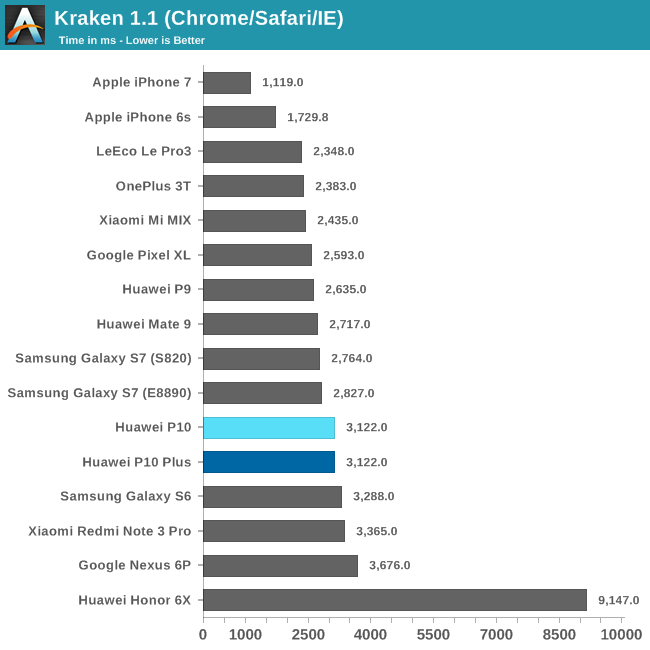
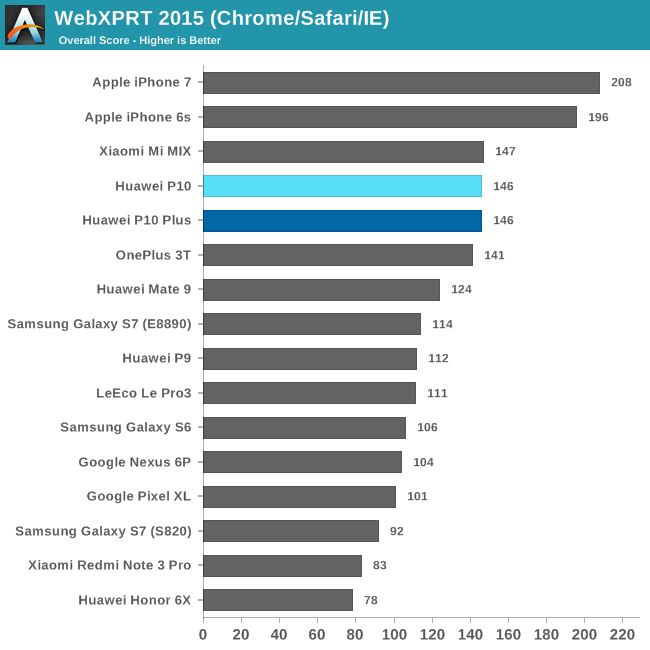
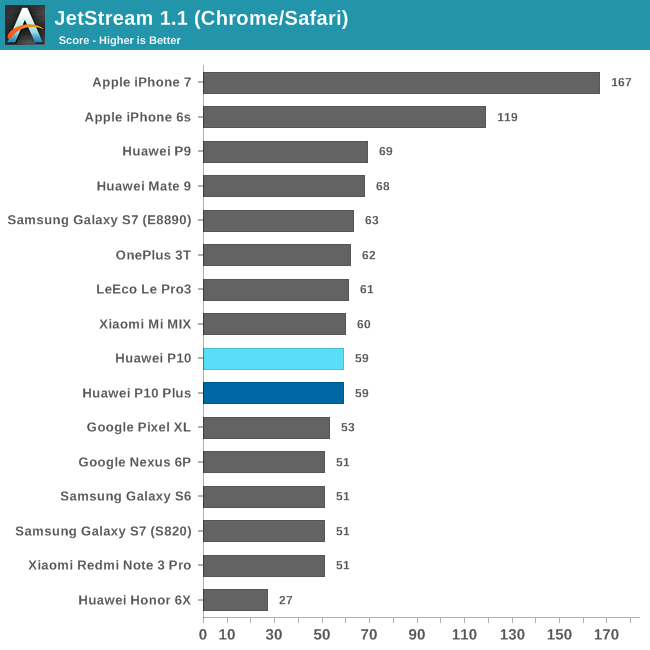
In the Kraken JavaScript test, both P10s fall behind the Mate 9 by 15%. The P10’s A73 CPU cores also cannot match the performance of the higher frequency A72s in the P9’s Kirin 955 SoC, or the custom Kryo cores in the Snapdragon 820/821 devices. The P10s do outperform the less-expensive Honor 6X by a factor of three, highlighting the performance deficit of using octa-core A53 CPU configurations instead of pairing the A53 cluster with 2-4 big out-of-order CPU cores.
Finishing positions flip in WebXPRT 2015, with the P10s out in front of the Mate 9 by 18% and the P9 by 30%. Scores in JetStream show less variation, but the P10s fall behind the Mate 9 and P9 once again by 17%.
The tests above corroborate my own subjective experience with the P10: It’s fast. Common tasks such as installing or opening apps, switching between running apps, and searching through my email inbox complete quickly. The redesigned EMUI 5.1 UI is smooth and responsive—not Pixel XL smooth, but flagship smooth.










74 Comments
View All Comments
Matt Humrick - Sunday, May 14, 2017 - link
It looks like the idle power numbers you quote were measured with the screen brightness set to maximum, so they are not very useful. The Kirin 960 SoC does draw more power than the Kirin 950/955 as our analysis showed, though. There are several reasons for this that are specific to this SoC and are not software related.Trixanity - Sunday, May 14, 2017 - link
Hmm, that appears to be the case but it seems odd that both the P9 and P10 reviews would have maximum brightness and the others would not. Makes no sense to me but of course that's something to critique the author of and not you :)I don't recall there being device power consumption averages in your analysis. I would like to see how various devices do. We all see how the iPhone pulls incredible idle/standby numbers (in hours) but starts to falter during load (probably due to the smaller batteries) and we also see how Samsung generally does well in load scenarios due to reasonably efficient internals including advances in AMOLED efficiency giving them an edge while getting flak for poorly optimized software (Snapdragon variant especially) that ruins the user experience with stutters.
ePambos - Sunday, May 14, 2017 - link
Dear Matt, thanks for your suggestion. Haven't tried putting the P10 in Airplane mode overnight, cause I still need to have access to phone calls. But keep in mind that the P9 was operating in the very same conditions. I will try to test force-using other bands than 4G and check wether it is a signal strenght issue related to one specific band...ePambos - Friday, July 7, 2017 - link
Hi... Just an update. After the latest firmware update -which clearly stated right at the top "enchancement in battery life- I can attest to enormous difference in the battery life of my P10. Now it is directly comparable to the battery life I was getting from my P9. Latest version is VTR-L09C432B150... Is there any chance to re-run some test (including idle power consumption)? It would surely make for a pretty intereting read to see how just a firmware update affects battery life or performance...ePambos - Friday, July 7, 2017 - link
Hi... Just an update. After the latest firmware update -which clearly stated right at the top "enchancement in battery life- I can attest to enormous difference in the battery life of my P10. Now it is directly comparable to the battery life I was getting from my P9. Latest version is VTR-L09C432B150... Is there any chance to re-run some test (including idle power consumption)? It would surely make for a pretty intereting read to see how just a firmware update affects battery life or performance...rubene66 - Sunday, May 14, 2017 - link
I am still waiting for the complete galaxy s8 exynos review !tuxRoller - Sunday, May 14, 2017 - link
F2fs shouldn't be noticably faster than ext4 except when a program forces an fsync.The fs mount options matter more than the fs when it comes to these two.
asfletch - Wednesday, May 17, 2017 - link
Late to the party I know, but P10 just arrived in Australian stores, so I got to play with one yesterday. It does seem snappy, but I had more missed touches than I've had with any other (expensive) phone. The factory screen protectors were left on, but they're pretty thin so shouldn't have been the problem.I checked YouTube and some reviewers are also experiencing this - did you experience it at all Matt?
JohnLinc - Friday, May 19, 2017 - link
This phone is very good based on performance registered12345 righttehranbarbary - Tuesday, June 6, 2017 - link
<a href="http://tehranbarbary.com" >باربری تهران</a>